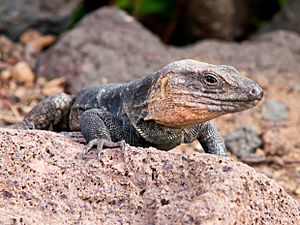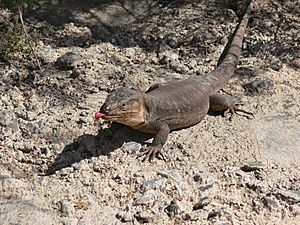Gran Canaria giant lizard facts for kids
The Gran Canaria giant lizard (Gallotia stehlini) is a really big lizard that lives on the Canary Islands. It belongs to a group of lizards called Lacertidae. These amazing reptiles are special because they are among the largest lizards in their family.
Quick facts for kids Gran Canaria giant lizard |
|
|---|---|
 |
|
| On Gran Canaria, Canary Islands, Spain | |
| Conservation status | |
| Scientific classification | |
| Synonyms | |
|
Contents
What's in a Name?
The scientific name for this lizard, stehlini, honors a Swiss scientist named Hans Georg Stehlin. He was a paleontologist, which means he studied ancient life forms like fossils. Mr. Stehlin was the one who first found the special lizard specimen that helped scientists identify this new species.
How Big Are They?
The Gran Canaria giant lizard can grow very large! It can reach a total length of up to 80 centimeters (about 31 inches), including its tail. This makes it one of the biggest lizards in the Lacertidae family.
What Do They Look Like?
These lizards come in different shades of gray, brown, and reddish colors. You can often tell the males and females apart. Male lizards usually have bigger heads and stronger jaws. They also tend to be heavier than the females.
What Do They Eat?
The Gran Canaria giant lizard is an omnivore, which means it eats both plants and animals.
- Young lizards often munch on small insects and other tiny creatures. They also eat plants and soft fruits.
- As they get older and bigger, their diet changes. Adult lizards mostly eat plants.
Where Do They Live?
This amazing lizard is endemic to Gran Canaria. This means it naturally lives only on this island, which is part of the Canary Islands in Spain. However, some of these lizards have also been introduced to another island called Fuerteventura.
What Is Their Home Like?
The Gran Canaria giant lizard lives in many different places on the island. You can find them in:
- Areas with temperate shrubs and bushes.
- Rocky places, including rocky shores near the sea.
- Pasturelands, which are areas where animals graze.
They can live from sea level all the way up to 1,850 meters (about 6,070 feet) high in the mountains.
Reproduction
The Gran Canaria giant lizard is oviparous. This means that the female lizard lays eggs. The young lizards then hatch from these eggs.
See also
 In Spanish: Lagarto gigante de Gran Canaria para niños
In Spanish: Lagarto gigante de Gran Canaria para niños



